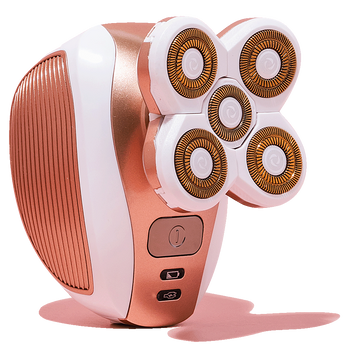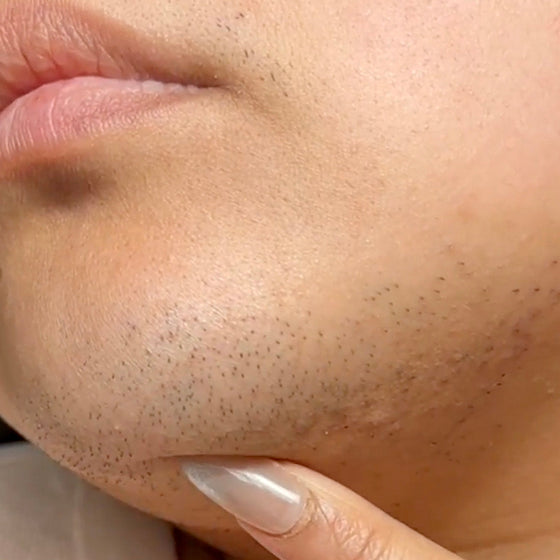First things first: the answer is yes. Facial hair is normal. It’s part of being a human, it’s part of being a woman. Every adult woman will have some form of facial hair, whether it's peach fuzz on the side of their cheeks, hair on the upper lip, or a few stubborn strands on their chin.
That being said, if you’re feeling self-conscious or embarrassed about visible facial hair… well, unfortunately, that’s normal, too. Western societal beauty standards make it seem like female facial hair is an unsightly problem to be solved, not an inevitable fact of life. So, if visible facial hair is making you feel less-than-beautiful, there’s something you can do about it.
We'll break down everything you need to know about facial hair in women, including what might be causing excessive hair growth and methods you can use to remove your facial hair (without causing skin irritation or redness).
Why do women grow facial hair?
All women grow some amount of facial hair, but some women grow darker, thicker, or otherwise more noticeable facial hair than others. The growth of excessive male-pattern hair in women after puberty is known as hirsutism. It’s the most common endocrine disorder, affecting nearly 10% of women in the United States. (“Excessive” is relative though – many women with less thick or coarse facial hair may still be concerned about it and wish to remove it.)
Here’s a list of common causes of hirsutism, or “excessive” facial hair:
- Polycystic ovary syndrome (PCOS). PCOS affects 5-10% of women of reproductive age and accounts for about 75% of all cases of hirsutism.
- Hormonal imbalances. Hirsutism is linked to male sex hormones called androgens. Excessive facial hair can grow if the level of these hormones increases or your body becomes more sensitive to them.
- Age-related changes. Hormonal changes related to menopause or aging can cause hirsutism.
- Ethnicity and race. Facial hair tends to run in the family. One 2014 study found that race (rather than skin pigmentation) predicts facial hair growth in women – Caucasian women had less hair growth than any other race while Indian women had more hair growth than any other race.
- Medications. Medications like androgens, glucocorticosteroids, progestins, and minoxidil (among many others) are known to cause hirsutism in some cases.
- Pregnancy. Pregnancy can cause a shift in hormones that triggers facial hair growth.
- Obesity. One study found that hirsutism was more prevalent among patients with a higher BMI.
- Stress. Stress and anxiety can affect facial hair growth in women.
How much facial hair is normal?
Look in a magazine and you might be convinced that NO amount of visible female facial hair could possibly be normal… but it is. While hirsutism affects around 10% of U.S. women, a 2014 survey found that three out of four American women ages 18-34 have removed facial hair the previous year. If you’re dealing with unwanted facial hair, you’re in good company!
That being said, how much facial hair is normal for you depends. Factors like genetics, race, age, hormones, and medical conditions all come into play.
If you’re concerned about excessive facial hair, consider asking a doctor. While facial hair itself isn’t a cause for concern (lip hairs can’t hurt you!), it could suggest a hormonal imbalance or present as a symptom of an underlying condition. Addressing hormonal imbalances or getting on medication could help to curb excessive facial hair in some cases.
How to deal with facial hair for women
Dealing with facial hair is a very personal journey. If your facial hair doesn’t bother you, all good – facial hair is normal and the primary reason to remove it is cosmetic. And we’re SO not here to tell you you need to remove body and facial hair to be beautiful. It’s just not true.
But if hair on your face does bother you, that’s normal, too. Unwanted facial hair can take a real emotional toll, and you’re certainly not alone in that. A 2006 clinical study found that 40% of women with facial hair felt uncomfortable in social situations, and 75% reported clinical levels of anxiety.
PCOS facial hair removal requires a more delicate approach than removing other body hair does, since facial skin tends to be more sensitive. Fortunately, there are multiple methods you can use to remove female facial hair without causing irritation, redness, or breakouts.
Here are a few ways to get rid of unwanted female facial hair:
Shaving
When it comes to removing facial hair, shaving is probably where your mind goes first – visions of your dad or boyfriend slathering their chins and cheeks in shaving cream, then using a plastic razor to shave it all away.
Shaving can work great for removing female facial hair, too – it’s painless and chances are you’re already plenty familiar with how it works. But shaving with body razors can lead to breakouts and irritation (especially if you reuse one you’ve been using elsewhere on your body.) Make sure skin is completely clean (ideally by using a sonic facial cleansing brush) and dry, then use a straight-edge, single-blade facial razor to gently remove female facial hair. Expect to do so every 2-5 days as hair grows back.
Dermaplaning
If you're interested quickly getting rid of fine facial hair, dermaplaning is the way to go. It's a pain-free, DIY method that goes way, way beyond hair removal, gently removing peach fuzz and dead skin cells for glowy skin, a smoother canvas for makeup, and better skincare product absorption. Professional-grade sonic dermaplaners like Nura make it easy to get salon-status, hair-free skin from the comfort of your home.
Waxing
Waxing is another popular way to remove facial hair. You can get waxed at a professional salon (pricey, but very effective) or try some DIY (it can be tricky to get the hang of but it works, especially if you’re mostly targeting less-painful-to-remove peach fuzz.)
Since waxing removes hairs from the root, its smooth-skin hair removal results last longer – you may not need to wax again for a few weeks. Just be aware that you’ll need to allow your hair to regrow to at least ¼ inch before you can wax it again.
If you have particularly sensitive skin, run a patch test with any wax you plan on using. This is to make sure the wax used doesn't cause any breakouts or irritation on your face.
Threading
Threading is another popular option when dealing with facial hair. It’s notoriously difficult to achieve the right angle and technique for threading on your own face, but professional threading is rather fast and affordable. Some irritation and redness is common, but it typically goes down in a few minutes. For those who are allergic or sensitive to wax, threading is a great alternative. Results typically last as long as waxing does, a few weeks.
Tweezing
Tweezing involves yanking individual hairs with a small tool. Since tweezing removes hair from the root, results can last for multiple weeks. Tweezing works best if you have a few straggling strands that can be easily removed, like eyebrow hair – it may be too time-consuming for excessive hair growth. What’s more, some dermatologists caution against tweezing as it can cause inflammation, irritation, and even potential scarring.
Professional laser hair removal
Interested in getting rid of facial hair for good? Laser hair removal is an excellent option. It involves using concentrated beams of light to target hair follicles and destroy them at the root.
In-clinic laser hair removal can be costly – think thousands of dollars – and you’ll need several sessions before achieving complete hair removal.
Meet Lumi, your gentle facial hair removal BFF
If you’re looking for at-home permanent facial hair removal, you’re gonna love Lumi. Lumi is a handheld permanent hair removal device that works similarly to laser hair removal. It uses intense pulsed light (IPL) to target hair follicles at the root and get rid of unwanted female facial hair for good. It provides results that are comparable to laser hair removal for a fraction of the price.
IPL hair removal is safe to use on the face below cheekbones. It’s FDA-cleared to provide permanent hair removal in just 6-12 weeks. It’s safe, pain-free, and easy to use. It’s our favorite way to remove facial hair permanently!
Sources:
- https://www.ncbi.nlm.nih.gov/books/NBK470417/
- https://www.ncbi.nlm.nih.gov/books/NBK470417/
- https://www.ncbi.nlm.nih.gov/pmc/articles/PMC4025516/
- https://www.ncbi.nlm.nih.gov/books/NBK470417/
- https://www.ncbi.nlm.nih.gov/pmc/articles/PMC3448401/
- https://www.nytimes.com/2015/06/11/fashion/sometimes-even-women-need-a-smoothly-shaved-face.html
- https://www.sciencedirect.com/science/article/abs/pii/S0022399906000420


.png?v=1727993165793&options=w_350)
.jpg?v=1724421708187&options=w_350)

.jpg?v=1724421459873&options=w_350)




